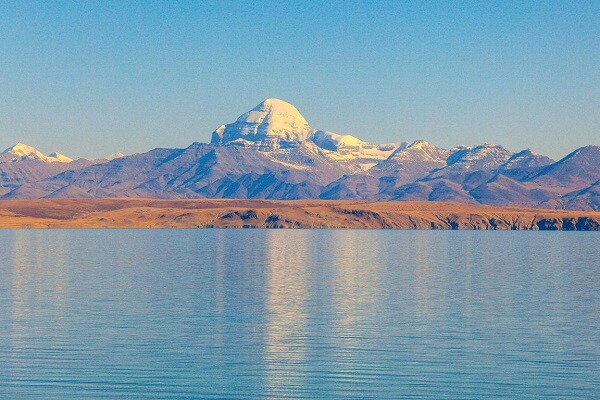Tibet is a mysterious plateau with countless lakes; among these vast or tiny mirroring puddles, two of them, Lake Rakshastal and Lake Manasarovar, are considered the most enigmatic of the mysteries.
IN TWILIGHT’S HUSH, THE TRUTH DOTH DRAW NEAR;
CELESTIAL AND APPARITION—TWAIN FROM ONE SPHERE.

Location of Rakshastal and Manasarovar
Lake of Celestial: Manasarovar
Lake Manasarovar is located south of Mount Kailash and is one of the three sacred lakes in Tibet (the other two are Yamdrok Lake and Namtso Lake). It is said that the “Western Paradise” described by Xuanzang in “A Record of the Western Regions of the Great Tang Dynasty” is Lake Manasarovar. In Hindu legend, this is where Lord Shiva and his wife, the goddess Uma, the daughter of the Himalayan mountain god, bathed.
Lake Manasarovar is a breathtaking expanse of water and one of China’s largest freshwater lakes. It is renowned for its remarkable clarity, allowing one to see deep into its pristine depths. Nestled in the Tibetan plateau, it lies gracefully between the majestic peaks of Mount Kailash and Mount Namunani, creating a stunning backdrop that captivates visitors.

Lakeside of Manasarovar
The name “Manasarovar,” which translates to “invincible jade lake,” evokes the imagery of shimmering green waters that glisten in the sunlight. In Tibetan, its meaning conveys notions of being “undefeated” and “invincible,” reflecting the lake’s revered status.
Manasarovar is steeped in history and spirituality. It is sacred in various religious traditions, including Bon, Indian Buddhism, and Hinduism. It is considered a holy pilgrimage site, drawing countless devotees who seek spiritual renewal and connection. The lake is also the birthplace of four principal rivers in Asia: the Horse River, later named for its swift currents, and the Peacock River, known for its vibrant surroundings. The Elephant River weaves through lush landscapes, and the Lion River flows majestically onward.
Often, visitors describe Lake Manasarovar as a tranquil oasis, a realm of peace where the landscape invites reflection and contemplation. Its profound cultural and religious significance continues to resonate, making it a cherished symbol of serenity in the hearts of many.
Lake of Apparition: Rakshastal
Nestled in Tibet’s stunning landscape, Lake Rakshastal, often called Ghost Lake, lies beside the revered Lake Manasarovar, separated by a busy highway. The lake gets its haunting name from a Tibtan phrase that translates to “poisonous black lake,” a fitting description considering its unusual properties.
Compared with Lake Manasarovar, Lake Rakshastal is full of darkness. There are no plants, cattle, sheep, birds, or even Mani piles and prayer flags on the lakeside. The whole environment is dead and lifeless.
The water of Rakshastal has a slightly salty taste and is deemed unsafe for humans and animals to drink, which only enhances its mysterious allure. Unlike its neighbour, Lake Manasarovar, known for its sacred significance, Rakshastal has a distinct character that sets it apart.

Lakeside of Rakshastal
Historically, this captivating body of water was once part of a much larger lake. However, over time, as glaciers melted and debris was left behind, the original water expanse split into two separate lakes. Recent climate changes have accelerated this process, increasing evaporation and shrinking glaciers, further reducing the lake’s area.
As a result, the lake now presents a striking contrast: the more significant portion boasts a more palatable flavour, while the smaller counterpart is laden with salt. The water in the smaller lake is less frequently replenished. With evaporation rates surpassing the natural flow of water,” minerals become concentrated. This transformation creates a water body increasingly unsuitable for use, lending itself to the eerie moniker of “ghost lake.” The haunting beauty of Rakshastal continues to captivate those who visit, inviting them to ponder its unique stories and natural phenomena.
Lake Rakshastal is a truly breathtaking sight, often celebrated for its stunning beauty, which rivals its famous neighbour, Lake Manasarovar. As visitors journey along the road, they are treated to a captivating view where the serene surface of the lake beautifully reflects the imposing silhouette of Mount Kailash, creating a magical scene. The water boasts a rich, deep blue hue that evokes tranquillity and mystery, inviting onlookers to pause and absorb the peaceful atmosphere. The striking contrast between the vibrant lake and the majestic mountain towering above forms a magnificent tableau of nature that leaves a lasting impression on all who encounter it.










